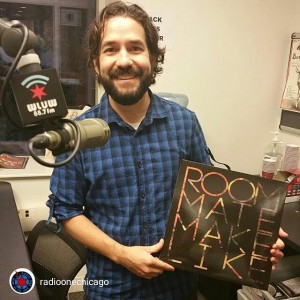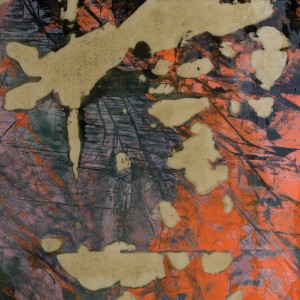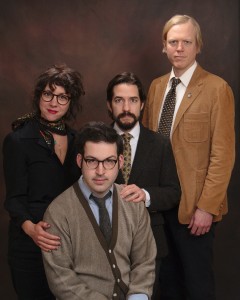Interviews
Here you’ll get to read interviews with Hidden Shoal artists and other folk we call our friends. Topics covered already include music, film, cats, ghosts, phonography, Hot Tub Time Machine 2 and LL Cool J to name but a few.
Brief Conversations: An Interview with Markus Mehr
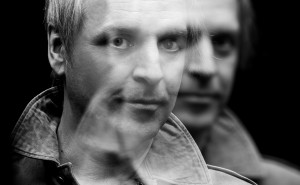 With the release of his new album Brief Conversations, Markus Mehr has delivered a stunning marriage of musicality and acoustic experimentalism. Through the capture and transformation of the sounds of the internal spaces we inhabit, Mehr presents a new kind of magical realism. With all those heady ideas in mind we thought it was the perfect time to sit down with him and have a chat.
With the release of his new album Brief Conversations, Markus Mehr has delivered a stunning marriage of musicality and acoustic experimentalism. Through the capture and transformation of the sounds of the internal spaces we inhabit, Mehr presents a new kind of magical realism. With all those heady ideas in mind we thought it was the perfect time to sit down with him and have a chat.
How are you managing in the current German lockdown?
I’m mostly at home. Since my studio is also at home, I spend even a little more time there. Of course I miss the opportunity to move freely and to meet friends. But in general, the corona crisis does not restrict me too much personally, neither physically nor mentally. My travel and consumer behaviour is generally not particularly extensive, so the quarantine hits me less hard than maybe others. The difficult part for all of us will occur after the lockdown I guess.
How did you first get into creating experimental music?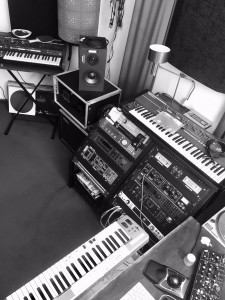
It was a slow process. I come from a rock background and at a certain point, however, there was a longing to start something new, to refresh things. So I focused my interest on electronic music but soon I noticed that it was not only about changing the field. I was chasing away more instruments than I added and suddenly there were tracks without a beat, without a meter, no melodies, no recognisable structures. That’s it, complete freedom. Our release history also shows very nicely that this development is a process that continues to this day and I hope this kind of naivety will go on as long as I release something.
Can you tell us what inspired you to create Brief Conversations
During the preparations for a commissioned work (EDIT 1/0/0/0, Moritzkirche, Augsburg) in September 2019, I had the opportunity to do recordings all alone in this beautiful, pure church. Just listening to this room several nights was a very inspiring experience. This gave rise to the idea of developing this approach, recording different rooms with different shapes, recording the quiet. To listen to what a room has to tell us – the sounds it creates, sounds which can be generated in it by different impulses – fascinated me. Brief Conversations describes these dialogues and summarises it in sonic narratives.
Can you give an overview of the kinds of processes involved in the recording and production of this album?
It starts with the recordings. My field recordings are always the basis. They often happen by chance. Some are also planned because I noticed a sound event the day before or because something attracts me, for example an empty parking garage, a stairwell, a tunnel or a synagogue. After capturing sounds I look into the recordings almost microscopically, searching for lively and emotional aspects. These can be rhythmic or harmonic elements. All sounds that have something to tell are considered. In order to create something new, I use tools like most “normal” musicians: pitch shifting, time manipulation, modulation effects, delays, equalisers, distortion. The resulting components, which add something to the dramaturgy and the dynamics of the story, remain in the track; the others get chipped away.
Can you outline how one of the tracks off Brief Conversations evolved, from the original sourcing of the sounds through to the refinement of the composition?
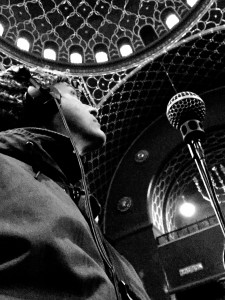 Ah yeah … I think of ‘Shelter’. I got permission to take pictures in a huge, disused gas tank. And when I was ready to record, the worst storm that can be imagined broke out. No hope of improvement for the rest of the day. Everything I recorded was covered with this kind of white noise, generated by the wind and the pounding rain. In response, I started stamping my feet and making loud noises to deal with the annoying noise. Fortunately, I also packed my contact microphone and recorded additionally the very deep resonance of the walls and railings. When I got home after hours I was sure that the recordings could not be used. But wrong: the contact microphones – with some support from the Mini Moog – form the foundation of the track. The percussive stamping and hits are almost unprocessed and with a pinch of digital sophistication I was able to elicit a few spherical and even harmonious elements from the room recordings. If one listens superficially, ‘Shelter’ may have a more synthetic appearance. In fact, it is a purely electro-acoustic piece. With field recordings you rarely get exactly what you expect.
Ah yeah … I think of ‘Shelter’. I got permission to take pictures in a huge, disused gas tank. And when I was ready to record, the worst storm that can be imagined broke out. No hope of improvement for the rest of the day. Everything I recorded was covered with this kind of white noise, generated by the wind and the pounding rain. In response, I started stamping my feet and making loud noises to deal with the annoying noise. Fortunately, I also packed my contact microphone and recorded additionally the very deep resonance of the walls and railings. When I got home after hours I was sure that the recordings could not be used. But wrong: the contact microphones – with some support from the Mini Moog – form the foundation of the track. The percussive stamping and hits are almost unprocessed and with a pinch of digital sophistication I was able to elicit a few spherical and even harmonious elements from the room recordings. If one listens superficially, ‘Shelter’ may have a more synthetic appearance. In fact, it is a purely electro-acoustic piece. With field recordings you rarely get exactly what you expect.
How important is the conceptual aspect of your work?
 Very important. In the past few years I have been working conceptually only. Before I start working on something new I think about things and do some research. Collecting and sculpting new music is preceded by a theoretical process… most of the time. And once a concept is conclusive, I try to stick to it as much as possible. I think it’s like writing a book. You have to have in mind the whole story and bit by bit you invent the narrative strands and the characters.
Very important. In the past few years I have been working conceptually only. Before I start working on something new I think about things and do some research. Collecting and sculpting new music is preceded by a theoretical process… most of the time. And once a concept is conclusive, I try to stick to it as much as possible. I think it’s like writing a book. You have to have in mind the whole story and bit by bit you invent the narrative strands and the characters.
What are you listening to right now?
BBC 6 Music.
Favourite releases of 2020 so far?
Acoustic Shadows by Lea Belucci, The Experience of Repetition as Death by Clarice Jensen and Motus by Thomas Köner are really inspiring records. Radio France broadcast a piece by Jim O’Rourke called Shutting Down Here (still available online). I was there when they performed this piece originally in Paris at the INA-GRM Multiphonies Series. It’s just brilliant. And my friend DOT made an album called Monsters … so good.
What’s your next creative project?
Basically I’m concentrating on a sound installation. But just because it feels right at the moment I started playing around with stuff for cello, viola and violin. This is quite the opposite of what I’m doing normally. And because I’m not that much interested in playing live any more, my long-time live visual partner Stefanie Sixt and I will turn towards short films a bit more. We recently released Separate Waves Of One Ocean, and the next one could come out quite soon. And here and there I help recording stuff for Slowvox, the project of my girlfriend. I’m really happy about all this things….
Some Links:
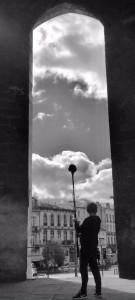 Markus Mehr – Brief Conversations
Markus Mehr – Brief Conversations
Jim O´Rouke – Shutting Down Here
Sixt/Mehr – Separate Waves Of One Ocean
The Spaces Between: An Interview with Memorybell
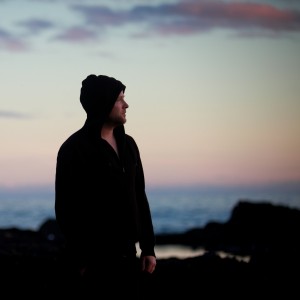 On his debut album as Memorybell, Grant Hazard Outerbridge delivered an abject lesson in need versus want. Obsolete is more than a simple minimalist document, indeed it could be argued that Outerbridge’s deft touch and innate sense of time make each of its sparse notes laden with import. As if each successive strike of hammer on piano wire were the only thing in the world… until the next. So it’s no surprise that Outerbridge is as much a thinker as a “feeler” when it comes to his musical work. In this utterly engaging interview the lovely Wagner Hertzog sat down with the artist and covered everything from Marvin Gaye to transient global amnesia. A truly great read.
On his debut album as Memorybell, Grant Hazard Outerbridge delivered an abject lesson in need versus want. Obsolete is more than a simple minimalist document, indeed it could be argued that Outerbridge’s deft touch and innate sense of time make each of its sparse notes laden with import. As if each successive strike of hammer on piano wire were the only thing in the world… until the next. So it’s no surprise that Outerbridge is as much a thinker as a “feeler” when it comes to his musical work. In this utterly engaging interview the lovely Wagner Hertzog sat down with the artist and covered everything from Marvin Gaye to transient global amnesia. A truly great read.
Many thanks to Wagner and Grant for their time and efforts in making this happen.
WH: You have been playing music for decades. Was the concept for Memorybell already in your mind before you started working on this music, or is it a more recent artistic project?
GHO: Memorybell is a very recent project. I wanted to focus on ambient music following the release of Genus Euphony, but the way this album came into being was decidedly unplanned.
I had been composing, shaping, and reshaping 20 or so songs but could never quite get them to feel the way I wanted them to. After I got out of the hospital, playing the songs was a uniquely unpleasant experience. They sounded awful to me and I had trouble remembering why I had written them in the first place. When a song felt wrong, I either threw it away completely, or focused exclusively on its essence (often just one or two chords) and explored that as granularly as I could.
My close creative collaborator from The Very Hush Hush, Peter Bo Rappmund, had heard most of the songs in various stages of their composition. When I was able to play these new, post-amnesia versions for him he strongly urged me to release the record under a new name. The songs were so different from anything I’d ever recorded that it made sense that they be the start of a new project.
WH: What are your main influences and sources of inspiration?
GHO: It sounds odd, but a lot of my musical ideas come from mundane objects. There is a particularly pleasant sound that the metal vent in the roof of my house makes when it lightly rains outside. In my old neighborhood, there was an old row house whose laundry exhaust whistled beautifully whenever it was in use. I could listen to the sounds of an oscillating fan all day long.
I enjoy sitting still and listening to the world, though it’s far too loud for me. This is one reason why I’m drawn to expansive silences. I draw an immense amount of inspiration and solace from the quiet that descends during a snowfall.
Less esoteric and more to the point, I find the following works very influential (in no particular order):
Marvin Gaye – What’s Going On
Air – Moon Safari
Billy Holiday – Solitude
Gas – Pop
Yo La Tengo – And Then Nothing Turned Itself Inside-Out
Stars of the Lid – The Tired Sounds of Stars of the Lid
WH: You seem interested in exploring extreme minimalism in your music, creating a slow, surreal experience for the listener. How did you come to develop such a style?
GHO: When I was studying classical music I was most attracted to dissonant passages. These “sour” notes and chords represented for me a warmer, more interesting way of approaching musical expression. I would sit for hours playing a single passage over and over, slow it down, and make subtle changes to it. As I grew older, I looked forward to this monastic repetition far more than completing whichever increasingly difficult piece of music I was learning.
Starting in the early 2000s, I played bass in The Very Hush Hush. Like the piano, my method of approaching the bass has changed over the years but, even back then, I was more concerned with playing the most interesting note than playing the root. One well-placed note can heighten anticipation in ways little else can.
My ears most want to hear what happens in the moments after a note is played before it dissolves into silence. That tension is powerful and shaping that tension is my primary concern.
WH: In terms of your creative processes, are you driven by your technique, or do you let your emotions drive your composing and arranging? Or is it a combination of both?
GHO: Emotion is the driving force behind my music.
To my ears, technique is only as useful as one’s ability to use it to express emotion. Technique for its own sake does little for me. It’s not that I don’t admire accomplished musicians, I do; I fully understand the time and dedication it takes to become an accomplished musician. But when technique becomes the focal point music becomes hollow. There is a whole spectrum of emotional experiences to be had while listening to music and feeling awe at someone’s ability is only one.
When I compose a new song, I try to keep my mind blank. Turn off my brain. Focus on what I’m feeling and sensing. What do I hear? What do I smell? Taste? I often begin with my eyes closed and open them once something interesting has presented itself. From there, repetition and manipulation of time and silence. How best to amplify what I’m feeling in the moment? What is the simplest way to say what needs to be said?
WH: Is there is a special place or time that you write music?
GHO: There used to be, but now I’m restricted to when my toddler son is either asleep or out of the house. Otherwise, he’ll come bounding from wherever he is and start mashing the keys. Adorable and amazing, but not conducive to thoughtful creation. I’m lucky if I get an uninterrupted chunk of 20 minutes per day.
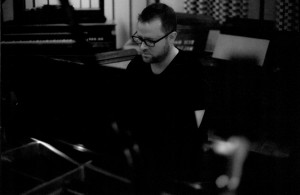 Place is an interesting problem with the piano. You’re stuck wherever the piano is. My work around for this used to be scribbling ideas in a notebook, studying them when I couldn’t be at a piano, etc. Now, unless I’m particularly inspired and one of my 20-minute mini-sessions produces something more-or-less fully formed, I’ll hold a strong phrase in my mind for as long as I have to until I have time to explore it at the piano.
Place is an interesting problem with the piano. You’re stuck wherever the piano is. My work around for this used to be scribbling ideas in a notebook, studying them when I couldn’t be at a piano, etc. Now, unless I’m particularly inspired and one of my 20-minute mini-sessions produces something more-or-less fully formed, I’ll hold a strong phrase in my mind for as long as I have to until I have time to explore it at the piano.
This results in a kind of fermentation. The most emotive part of an idea tends to become stronger, while the less necessary, more ancillary bits float off. This won’t always be my song writing process but, considering my 2 year-old just had a baby brother, I don’t see it changing in the near future.
WH: How do you work on individual songs? Do they keep evolving as you experiment with them over time, or do you find it quick and easy to finish each piece?
GHO: It depends on the song. Many songs are vague and gauzy at the start and I have to sit with them for a while before they reveal themselves to me. I try not to force anything onto them, just wait for whatever emotion it was that drove me to sit down at the piano to come out. Sometimes this process is quick, other times it is glacial. It took 14 years for ‘Somnolent’ to become what it is.
That’s an aberrant example, though. Most songs take on average 2-3 years before I finally leave them be. So, at any given time, the batch of songs I’m working on tend to have been initially conceived several years previous.
Occasionally, a song will emerge and I can’t figure out how to improve it. Those are always happy moments, though infrequent. I quite enjoy the long, slow evolution of a song. When one is finished, it may sound quite unlike it did in its infancy.
WH: In regards to your artistic process, are you a perfectionist, or more of a relaxed creator?
GHO: A complete and utter perfectionist, though I’m trying to let that go. My compromise is to direct my perfectionist tendencies toward my process rather than toward my music, to stay dedicated to giving the songs room to breathe, to grow, to change. Rather than try to force the songs to be something I want them to be, I allow them to be what they are. Even if I don’t like the end result, being true to the process feels like being true to my nature.
The most important part of my process is letting go. Ego can be a useful tool, in crafting personae, in pushing yourself, but I find it a barrier to making meaningful music. My best songwriting comes after I’ve processed whatever drove me to write a song in the first place. What remains after the dust settles.
WH: Silence, and the ambiguity it evokes, plays an important role in your music. Is this aspect of your music planned, or do you improvise?
GHO: Very much planned, as much as one can plan silence. I can never predict the affect any given length of silence will have, so I conduct tests. Do I add a single beat here? A measure of seven? Thirteen? It’s a little like introducing oneself to a strange animal.
As consumers of popular music our ears have been trained to expect predictability in regards to rhythm. 4/4 and 3/4 dominate the sonic landscape. The ghost of the Western classical music tradition is persistent. The purposeful shirking of predictable time signatures is a good thing but if not approached carefully it can estrange the casual listener.
When I shape the silence in my songs, I pay close attention to what my ears want. Then I give them something else. Unusual time signatures often do the trick, but I try not to employ them for their own sake. Sometimes a standard time signature alternated with an irregular or changing amount of silence has a magical effect. The ultimate test is if someone can’t tell that a song is in 17/8 or 13/4.
The ideal is to make the unexpected feel natural.
WH: Can you tell us about your experience of transient global amnesia and how it influenced the creation of this album.
GHO: In late February of 2014 my first son was two weeks old. He was curled up with my wife on the couch and I left to meet up with some friends. We had a couple of beers and I made my way home. It was lightly snowing.
I walked in the house and my wife and son were still curled up on the couch. I took my son upstairs, swaddled him and put him in his crib, and put on my headphones.
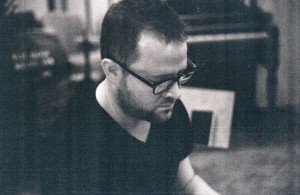 I woke up in a hospital roughly ten hours later on a gurney, obscenely bright fluorescent lights flashing over my face. I saw my wife and asked, “What am I doing here?” She patiently recounted the story of how I had come into our bedroom saying I couldn’t remember where I had been, what I had done, the people I had been with; how she had called the police, to whom I had apparently been quite charming and funny, who in turn summoned an ambulance that brought me to the hospital.
I woke up in a hospital roughly ten hours later on a gurney, obscenely bright fluorescent lights flashing over my face. I saw my wife and asked, “What am I doing here?” She patiently recounted the story of how I had come into our bedroom saying I couldn’t remember where I had been, what I had done, the people I had been with; how she had called the police, to whom I had apparently been quite charming and funny, who in turn summoned an ambulance that brought me to the hospital.
My poor wife told me this story over forty times before it stuck. Tests were run; EKGs, MRIs, CAT scans, toxicology screens. At one point, a group of medical students with clipboards surrounded my bed.
Throughout it all, my wife sat holding our absurdly small son wondering if I’d had some sort of stroke.
I was diagnosed with Transient Global Amnesia, which is, maddeningly, a diagnosis by exclusion. Once everything else has been ruled out, that’s what you get, a rare condition about which little is known. Extreme stress, sleep deprivation, and excessive physical exertion are thought to be the triggers.
The effect was as if a bomb had gone off in my brain. All memories months into the past and future were turned to glass.
The tests showed an increased sensitivity to light and sound. This proved problematic with a small baby at the house. I was given to carrying earplugs and noise-cancelling headphones with me for diaper changes. Going outside without sunglasses triggered a migraine. A screaming police siren triggered a migraine. A teakettle triggered a migraine. A loud sneeze triggered a migraine.
I quit my job. The thought of trudging through that soulless routine coupled with my new condition caused me so much anxiety I couldn’t function.
I was home all the time. When my son was sleeping, I had to do something. When my son was at day care, I had to do something. When I couldn’t sleep, I had to do something. I turned to the piano.
The songs I had been working on for the previous few years sounded like boxes of broken glass. Some of them literally gave me headaches. To heal, I picked them apart, focused on the parts that were soothing, that felt right, and threw out what remained. I reshaped them, let them ring out into silence, and created something new.
WH: Did you know beforehand that you were writing songs specifically for this album, or did you choose from songs that had already been written?
GHO: I chose from songs I had previously written, but completely altered them, post-amnesia. I had a concept for an album I had been pursuing before I awoke in the hospital. That’s the raw material to which I returned
At the time, it was important to me to force the issue, to make the collection of songs work even if they felt wrong. That’s when I really started focusing on silence. I threw out the superfluous, ornamental bits and chiseled the songs to their core. Then I wrapped them in silence.
WH: The title of the album, Obsolete, is very evocative. How did you settle on this title, and what does it mean to you?
GHO: I really don’t like titling my own songs. When I do, they’re almost always non-sequiturs. I reached out to an old friend, gave him the raw, un-mastered tracks and asked him to title the songs. He suggested the title track be named “Requiem for Obsolete Technology.” A great song name, to be sure, but I felt single word song titles were more apropos, given my editing method and interest in silence.
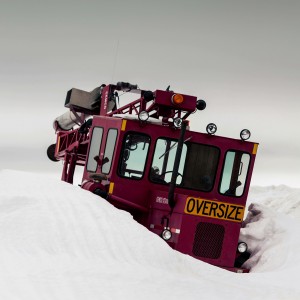 In general, I often feel like I was born a couple hundred years too late. The world is the loudest it has ever been, and for someone who craves quiet it is a struggle to remain focused amongst the head-splitting sounds of squealing brakes, screaming people, crackling electric lines, and wailing sirens. I like to imagine what the world must have sounded like before the industrial revolution.
In general, I often feel like I was born a couple hundred years too late. The world is the loudest it has ever been, and for someone who craves quiet it is a struggle to remain focused amongst the head-splitting sounds of squealing brakes, screaming people, crackling electric lines, and wailing sirens. I like to imagine what the world must have sounded like before the industrial revolution.
Actually finding a quiet place is becoming more difficult. I live in Denver, Colorado and the legalization of marijuana, along with our city’s policy of being as inviting as possible for new businesses, has created an immense influx of people. City streets are jammed beyond capacity, and what used to be an easy drive into the mountains has become an arduous chore. Hiking trails are as clogged as motorways. Landmarks are being vandalized.
Quiet places are vanishing. So I create them in music.
WH: Did you work on the songs for Obsolete individually or collectively? The titles of the songs suggest a link between them.
GHO: The songs I ended up including on Obsolete were originally written at completely different times. The only thing they had in common was the fact they were the ones I had been drawn to in the years and months leading up to my amnesia. When I slowed them down and picked them apart after my return from the hospital, I noticed new patterns and arranged their order on the album accordingly. I rarely worked on one song at a time. I typically shaped the whole set of songs at once. If I made a severe edit on one, it often let to a complementary edit on another.
I touched on this earlier, but I find naming my own songs difficult. My natural inclination is to be abstract and sarcastic with names, but I felt it would be a disservice to the honest and existential nature of these songs to name them so. The titles of the songs are representative of various themes that were woven through my life when I reworked them. Koan is inspired by the Richard Brautigan poem, “Karma Repair Kit, Parts 1-4.” Ambulator is in reference to the Max Frisch novel, Man in the Holocene.
Both of these speak to me on a level that is difficult to articulate. “Karma Repair Kit” is a reminder to be still and accepting. Not of anything in particular, but of everything in general. Man in the Holocene is a meditation on loneliness and struck a note within me during my recovery, despite the fact I read it a very long time ago; it just bubbled up out of my mind.
The other song titles are fairly literal and loosely based on my friend’s suggestions. 2014 was unequivocally the worst year of my life. The amnesia wasn’t even the most difficult struggle, but I’m not going to elaborate. The songs are my way of processing what happened.
WH: What’s the main intent behind your music? What are you trying to communicate to your listeners?
GHO: That sitting still, especially when it is uncomfortable, is important; that the act of listening, whether it’s active or passive, is important. It slows down your thoughts, so you can spend time with them. Depending on your type of mind or life situation, that may not be desirable, but then it is all the more impactful.
Modern city life is fast and loud. We run around from place to place, from work to home, from the gym to the grocery store, checking our watches or phones, making sure we don’t miss appointments; little of that matters to our internal lives. We focus so intently on what we have to do that we rarely stop to think what we would like to do. Or what we should do, not only for our own happiness but also for our own mental health.
Slow down and take a nap. Memorybell can help.
WH: Do you have a lot of unreleased songs?
GHO: I rarely make a proper recording until I’m satisfied that I have a cohesive collection of songs. I have a few songs that didn’t make the cut for Obsolete, but if I do anything with them, I’ll probably chop them up and use parts of them in another project. I’ve reworked one song that didn’t fit the way I wished it had for Obsolete and will most likely include it on the next record.
I don’t have a lot of unreleased material but I do, however, have a lot of unrecorded material. I don’t write any musical ideas down, I just run the songs through my head over and over. I have several albums worth of songs in various stages of completion floating in my brain. Sometimes I’ll carry a song around for years before I return to it. One song I’ve been working on for 19 years and it still hasn’t fully revealed its mysteries to me. My approach is that if something is worth recording, I’ll remember it. Thankfully, the part of my brain that stores my musical ideas seems largely unaffected by my amnesia.
WH: Are you currently working on something? What can we expect next from Memorybell?
GHO: I’ve had my fill of reworking old material for the moment. I’m moving forward with my new approach and writing an album from scratch. It’s very freeing, and my process has quickened; I’ve let go of thinking of any given idea as precious, as worthy of meticulous appreciation. If something doesn’t feel right, it’s gone. If some essence of it sticks around, then it has merit and will find a place in some different form. It’s a looser and faster method than I’ve ever used before. I’m halfway done with the follow-up to Obsolete. The songs still breathe slowly and are still melodic, but it’s somehow…different.
 My main obstacle is lack of time. I have a 2 year-old and a newborn at home (both boys) and, unlike when I wrote Obsolete, I am now gainfully employed. My time to write is limited to naptime, or those rare occasions when I’m home alone. I’m finding it helps, actually. I carry around the songs in my head, tweak them, try different arrangements, and then when I finally have the time to play them and test my ideas out, the good ideas tend to present themselves more or less immediately.
My main obstacle is lack of time. I have a 2 year-old and a newborn at home (both boys) and, unlike when I wrote Obsolete, I am now gainfully employed. My time to write is limited to naptime, or those rare occasions when I’m home alone. I’m finding it helps, actually. I carry around the songs in my head, tweak them, try different arrangements, and then when I finally have the time to play them and test my ideas out, the good ideas tend to present themselves more or less immediately.
Whatever comes next will be looser and more organic.
—
Memorybell’s debut album Obsolete is available now through Hidden Shoal. Head to the artist’s profile for all links and more info.
MAKE LIKE: An Interview with Roommate’s Kent Lambert
Chicago band Roommate, led by Kent Lambert, came to our attention in the second half of 2015 thanks to a glowing review of their fourth album MAKE LIKE on review site Coke Machine Glow. Since then, it’s been blasted regularly in the Hidden Shoal offices, and has received an extensive review on the blog of Hidden Shoal’s Tim Clarke. After contacting Kent about the release, Tim conducted an illuminating interview with Kent via email.
TC: This year you released your fourth album as Roommate, MAKE LIKE. Listening back to your discography, there’s a clear evolution away from electronic sounds towards a more sophisticated, full-band sound. How do you feel about the album now it’s been out for a while, and how do you see it sitting in relation to the rest of your releases?
KL: I’m going to quote from my application for the Illinois Arts Council grant that helped fund the album’s release. I wrote this text almost a year ago. Keep in mind that I was trying to convince strangers to give me money, so I come off as more grandiose and less humble than I otherwise might:
“I consider the album to be a pinnacle of my own career as songwriter and music producer, and a definitive representation of the band’s transformation from intimate, lo-fi, solo affair to cohesive, creatively ambitious, organically collaborative band… More than any past Roommate album, MAKE LIKE is the result of a collaborative decision-making process, and its songs were arranged for live shows before being translated into recordings. As with past Roommate albums, I wrote all of its songs in solitude. Unlike with past Roommate albums, all of its instrumental arrangements, recording processes and mixing decisions were conducted collectively. Though this album is ultimately a collection of my songs and its production was directed and managed by me, it is a document of a band, of multiple distinct sensibilities converging and diverging to untap and maximise the songs’ emotional, sonic and kinetic potential.”
A year later, I’m going to quote from your review, it describes very well (and much more concisely) how I feel about the album: “a culmination of all that’s come before it – a distillation of an aesthetic and a refinement of purpose.”
TC: Can you tell me a bit about your songwriting process, perhaps giving a couple of examples of how some of the songs on Make Like evolved.
KL: From 2000 to 2013, I continuously wrote material that eventually became songs on various Roommate albums. Some songs came together very quickly, others existed as pieces and parts, phrases and ideas, for months or even years before they cohered into a complete song. The process was basically me carrying these parts around, in notebooks or in my head, and filtering the stimuli of my daily life into parts that might lock together with pre-existing parts. For example, the line “lodgepoles are all getting eaten alive” in ‘RIOT SIZE’ was something my dad said on a camping trip in 2008 (he was pointing at and describing swaths of forest that had been destroyed by mountain pine beetles). I kept that little piece in my head, along with something about a tiger, and then in 2011, in the midst of the Arab Spring and protests in Wisconsin over collective bargaining, the rest of that song came together within a few weeks, and those little lodgepole and tiger puzzle pieces found their place. By the time I wrote ‘PEOPLE ON SCREENS’ in January 2013, the rest of what would become MAKE LIKE had already been written, and I had a pretty good idea of how it would be sequenced, and of some of its overarching themes. I felt like there needed to be one more song. So I wrote most of ‘PEOPLE ON SCREENS’ in one sitting. I think it came together so quickly because it had all of these other songs to support and inform it.
TC: Your current line-up includes some pretty stellar players who also play in other Chicago bands. Do you have a clear idea of what you want the band to contribute to your songs, or do you let them create their own parts independently?
KL: It can vary from song to song, but our album arrangements are typically a mixture of parts I’ve come up with and parts that the other players figure out independently, or together as a band in rehearsals and recording sessions. The typical process is that I write the song and record a demo of it on my own, so that my bandmates can learn the song before we get together to arrange it for live shows. The demo will have placeholder drum, bass, synth and vocal parts, basically whatever comes to mind as I quickly try to sketch the song out. I am usually not attached to those parts and encourage my bandmates to replace them with new stuff, but in many cases they get very attached to the demos and sculpt their parts from those placeholder arrangements. On past albums, the demos would typically form the skeletons of the songs’ album versions, with my bandmates and I recording new parts around them (e.g. ‘MY BAD’ and ‘AUGUST SONG’ on Guilty Rainbow), but with MAKE LIKE, we arranged and played the songs live for a while before we worked on them in the studio. In the case of ‘OLD GOLDEN,’ the album arrangement is quite different from the original demo – that song evolved considerably through multiple live arrangements before settling into its album form. By contrast, ‘DANCER HOWL’ is much closer to the demo. The guitar figure that repeats through the verses and early ‘choruses’ is directly taken from the demo (although of course Sam fleshed it out with gorgeous tone and articulation) and we flew in the electronic drum parts from the demo and processed them through outboard gear.
TC: I find your lyrics and vocal delivery to be incredibly affecting. You manage to strike a difficult balance between the specific and the universal. I’m never exactly certain of what you’re singing about, but I understand what you mean – if that makes sense! At what point in the songwriting process do the lyrics take shape, and do you feel there are certain themes or ideas that recur in your songs?
KL: It’s extremely gratifying to get that feedback! What you say makes perfect sense to me, and though I’ve never articulated it that way, I’d say that striking that balance (between the specific and the universal, between cerebral ambiguity and emotional clarity) has been an underlying goal of my songs in recent years. I’m not interested in or comfortable with writing literal, confessional songs, but I’m also not interested in escaping into a fantasy or musical genre-fetish persona… I suppose I write songs as some kind of self-therapy. I meditate on my personal world and the social communities around it – my own creative communities, the city of Chicago, and beyond. The lyrics pretty much always come first. I might have some chord fragments or keyboard riffs floating around, waiting for lyrics to bond with, but it’s the lyrics that drive the process and turn the fragments into songs. I try not to analyse my own songs too intensely, I leave that to people like you, but yes, there are definitely themes and ideas that recur. My songs tend to come directly out of my anxieties, and those anxieties certainly have recurring themes. A prominent theme would be my anxiety with my own tremendous, ridiculous privilege as a comfortably employed white American man in the 21st century. I feel a burning itch to reckon with that privilege, to scratch at it, question it and atone for it somehow, I suppose. Other themes that I consciously reflected on while writing MAKE LIKE involved the kind of identity slippage facilitated by social media and immersive video games, the ease with which we can ‘connect’ with childhood friends, casual acquaintances and strangers through status updates and 3D avatars in violent virtual spaces, the beauty and horror that can live on the surface of those experiences, and the loneliness that often lies at their core… Or something like that?
TC: The production on MAKE LIKE is incredibly deep and rich. Can you talk about your relationship with Nick Broste and how you approached production on the album?
KL: We’d all known Nick for many years (he’s been a ubiquitous presence in Chicago’s music scene doing live sound and as a trombonist in Mucca Pazza and many other groups) but we’d never recorded with him. In 2012 we played a couple of shows at The Hideout for which he was running sound. We were very pleased with our stage mix and the feedback we got on how it sounded in the room. After one of those shows he told me that during ‘SECRET CLAW’ (a very new song at that point) he’d gotten very creative with the live mix, turning certain elements up and down and manipulating effects at various points in the song, and he sort of pitched the idea of helping us record a new album. We’d always self-produced with the incredible help of our good friend Gerard Barreto, but for a fourth album I was open to changing up the equation. I’d been fortunate enough to accumulate some complimentary recording days at John McEntire’s now-private SOMA Electronic Music Studios (my grandmother’s Mason & Hamlin piano was housed there for a couple of years), so Nick and I made some plans to do a bunch of tracking there. I think Nick was accustomed to a more straightforward recording process, wherein a band more or less documents their live show in the studio, followed by overdubs and mixing. We did a version of that by tracking basic rhythm section parts first, but for us, tracking and mixing are intertwined throughout the entire production process. Our process relies heavily on intuition, experimentation, trial and error – we’d listen to the evolving mixes to try to divine what else needed to be added. Once Nick got used to this process, he dove in headfirst and became a sort of mad sorcerer mastermind. He’d conduct all sorts of experiments with various outboard gear at SOMA (while talking to himself in various Spinal Tap-esque characters), he’d send tracks to tape or through his Memory Man pedal, he’d come up with counter-melodies (the Stereolab-like Farfisa part on ‘OLD GOLDEN’ was his creation) and strange textures… he basically became another member of the band. There were countless hours of tracking and mixing that just involved Nick and me.
TC: MAKE LIKE was mastered by Rashad Becker, who’s pretty legendary among those in the know, and who seems to have an exhaustive understanding of audio. How did you come to work with him? Have there been albums he’s worked on that you admire? What do you feel he brought to the album’s final incarnation?
KL: I don’t tend to pay too much attention to the technical personnel on albums I love, I typically just let my friends and collaborators educate me on such details. So I hadn’t heard of Rashad Becker until a conversation with my friend Cooper Battersby (he’s in CAVE and Bitchin’ Bajas and is an accomplished sound engineer and producer in his own right) when MAKE LIKE’s final mixes were on the horizon. Nick and I were a bit concerned with the robustness and density of the low-end in our mixes. Cooper was thrilled with Rashad’s work mastering CAVE’s album Threace, and he was confident that Rashad’s work on so many incredible bass-heavy electronic music records more than qualified him to help preserve the clarity of our mixes. I looked him up and realised he’d mastered many, many albums I listened to heavily in the aughts (e.g. Lali Puna’s Tridecoder and Scary World Theory, Morr Music’s Blue Skied An’ Clear complilation) and more recently (Fennesz’s Becs and Pantha Du Prince’s Black Noise), so I was determined to work with him, or at least to have someone at Dubplates & Mastering do the job. I think he did exactly what Cooper said he would – he applied a light but firm hand to the mixes, preserving and gently enhancing their clarity and dynamics. He kept the bass-y elements from becoming the muddy over-compressed mess that could have resulted from other engineers and facilities.
TC: When I first got in touch with you and asked about whether MAKE LIKE was going to be released on CD, this sparked a conversation about how frustrating it can be to continue making music when recouping costs has become close to impossible. How big a part does Roommate play in your life, and how do you see that changing in the future?
KL: I’ve worked various part-time and full-time jobs in the 15 years that Roommate has been a thing, and I’ve been active as an experimental videomaker, and played in other bands (the most recent and active of them being The Father Costume), so Roommate is one of many projects I’ve juggled in that time. But in terms of the sort of psychological/emotional/psychic presence it’s held in my life, it’s often felt like the central activity of my life, and there have been sustained periods of months during which it has more or less been a second full-time job, particularly during album production, mixing/mastering, release and touring cycles. I stopped writing new material after ‘PEOPLE ON SCREENS,’ I think I wanted those cycles to stop, at least for a while. I wanted a clean break – a break from new material to obsess over, from the costs and logistical headaches of studio recording, from the infinite decisions and minutiae involved in recording, mixing and mastering, and especially from the label/publicist/promotion/business side of it. I didn’t and don’t want to end the band, but I did make a conscious choice to stop participating in the traditional (and seemingly outmoded?) album release model that we and so many of our peers have used for years. That doesn’t mean I won’t record music again, but I am definitely not generating songs the way I did for so many continuous years.
So I really don’t know what role Roommate will play in my life in the future, but I’m keeping an open mind about it. In June we had a residency at our favorite Chicago venue The Hideout, which entailed a different show every week for five weeks, with different musicians and songs in each installment, and in the lead up to and during that residency, Roommate felt like two or three full-time jobs. But it was an intensely rewarding experience. It made old songs feel new again, and it involved so many different collaborators: the four-piece at the core of MAKE LIKE, numerous ‘alumni’ from past incarnations of the band, and a few incredible musicians with whom I’d never performed before. There was a program of music videos (including an interactive art-game by Thorne Brandt that will presumably be made public in 2016), a live score to 16mm films performed by Sam Wagster and me, and chamber ensemble versions of a few songs. I came out of the experience with a renewed confidence in the depth of the catalogue, and in the potential for the project to continue to mutate and reincarnate, even if there are no more proper albums for a while, or ever.
TC: As far as I’m concerned, 2015 has been an absolutely stellar year for music – including outstanding releases by Jenny Hval, Jim O’Rourke and Björk to name a few – with Roommate’s MAKE LIKE as my favourite of them all. Which records have you held close this past year?
KL: It’s amazing to me that our record would be in the company of, let alone top, those records you mentioned! It does really seem to have been a stellar year for music. I find it difficult to keep up with and fully appreciate music during its initial release cycle. For example, I listened to Dirty Projectors’ Swing Lo Magellan in 2012–13, but it wasn’t until this past summer that I really, really got into it, and 2015 was also the second year in a row that I listened to MGMT’s 2010 album Congratulations semi-obsessively… But that said, in 2015 I spent much time with and got a great deal out of the latest albums by D’Angelo, Holly Herndon, Joanna Newsom, Kendrick Lamar, Julia Holter, Dungen, Sufjan Stevens and Flying Saucer Attack, as well as the Björk and Jim O’Rourke records you mentioned (Jenny Hval is on my radar but I haven’t dug into her music yet) and an amazing work from a large ensemble called Never Enough Hope (it includes Nick Broste and a couple other Roommate alumni, Amy Cimini and Erica Dicker). The composer and leader of the group is Toby Summerfield and the album is called The Gravity of Our Commitment. It’s phenomenal.
TC: And finally, what’s with the digital handclap sound that keeps cropping up in MAKE LIKE?!
KL: I don’t know, we got a Yamaha drum-pad at some point during the production of the album, and a couple of its clap samples became as crucial to us as a shaker or tambourine. I definitely felt a craving for sort of ’80s science fiction movie atmospheres and textures to be strongly represented on this record, and the handclap sort of encapsulated the fulfillment of that craving, particularly at the ending of ‘WILDERNESS.’ A digital clap through some precisely calibrated delay effects, at particular subdivisions of the beat, is an exquisite thing!
Hidden Shoal would like to thank Kent for taking the time to chat with us. Roommate’s MAKE LIKE is available on vinyl, cassette and digital download via Strange Weather Records and Bandcamp.
Sonic Transmutation: An Interview with Markus Mehr
Sonic Transmutation: Markus Mehr, the Modular Orchestra and the Chamber Choir of Augsburg University perform ‘Gymnasium/Swarms’
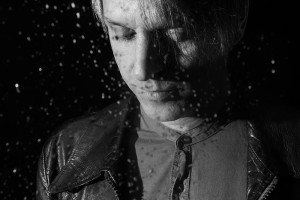 As one of the shining gems in the Hidden Shoal catalogue, Markus Mehr isn’t just a musician – he’s a sound collector, an arranger, an audio artist, a field recordist and a master of aural assemblage. In June, Mehr performed at the Modular Festival in his home town of Augsburg, Bavaria. But this was no usual Markus Mehr performance. Along with his regular collaborator, video artist Stefanie Sixt, Mehr was joined by the Chamber Choir of Augsburg University, the Modular Orchestra, and conductor Michael Kamm in a performance of ‘Gymnasium/Swarms’ from Binary Rooms. It was the first time Mehr’s music had been given the orchestral treatment, as his inorganic sounds, field recordings and heavily effected synths were rendered acoustic by a cast of dozens of musicians before a crowd of 2,000. Mehr spoke with Matthew Tomich about this highly unusual collaboration.
As one of the shining gems in the Hidden Shoal catalogue, Markus Mehr isn’t just a musician – he’s a sound collector, an arranger, an audio artist, a field recordist and a master of aural assemblage. In June, Mehr performed at the Modular Festival in his home town of Augsburg, Bavaria. But this was no usual Markus Mehr performance. Along with his regular collaborator, video artist Stefanie Sixt, Mehr was joined by the Chamber Choir of Augsburg University, the Modular Orchestra, and conductor Michael Kamm in a performance of ‘Gymnasium/Swarms’ from Binary Rooms. It was the first time Mehr’s music had been given the orchestral treatment, as his inorganic sounds, field recordings and heavily effected synths were rendered acoustic by a cast of dozens of musicians before a crowd of 2,000. Mehr spoke with Matthew Tomich about this highly unusual collaboration.
MT: How did this performance of ‘Gymnasium/Swarms’ come about?
MM: Back in 2008, I was working for Modular Festival in Augsburg. I was hired as a creative director or ideas person, or something like that, and my job was to create ideas and collect ideas from other people and bring in projects and art across all kinds of disciplines – not just music. All the projects lead to this new festival and we thought it would be great to connect the local music scene with the classical music scene, the pop music scene with the classical music scene. This is not new, but unless you’re Metallica, it’s impossible, as a local musician or as a starter, to play with an orchestra, so I thought it would be a great idea. And it needn’t be that typical Night of the Proms thing – do you have this in Australia, do you know what I mean?
MT: No, I’m not sure what you mean.
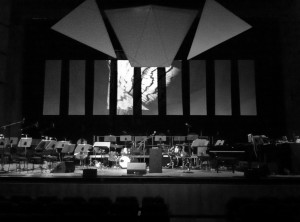 MM: We have this in Europe and it’s very successful, where a bunch of aged stars from the ’80s sing their songs with a musical accompaniment embedded in an orchestral context. They fill stadiums here with this boring shit. We didn’t want this project to be like that – the songs from the bands should be cut into pieces and put together in a completely new way. It should be very unusual and new. The difficult thing was to find local conductors and writers who can deliver that, but it was successful. I had two guys at the time, both of whom had one foot in the pop context and the other in the classical context, and one of them – Michael Kamm – was also the arranger of ‘Gymnasium/Swarms’. We started out in 2008 with this and called it ‘Puppet on a String’. And it was successful – very successful – and the ‘Puppet on a String’ project is still the opener of the Modular Festival. It’s become bigger and bigger over the years, and we played this year in front of 2,000 people – so that’s a great thing. The end of the story is that I only worked for them for two years, then I left it, and this year they asked me to play with them – as a kind of homage if you like, or because they love the album, I don’t know! And I thought it was a cool idea from the beginning, because it was my idea [laughs]! So it was a unique opportunity to do this stuff, and it’s obviously a fantastic thing to stand in front of a choir of 40 people and to stand in front of this orchestra – it sounds beautiful. So that’s the whole story. I invented this event because it was my job somehow, and I saw it growing, and this year they asked me, and I said yes.
MM: We have this in Europe and it’s very successful, where a bunch of aged stars from the ’80s sing their songs with a musical accompaniment embedded in an orchestral context. They fill stadiums here with this boring shit. We didn’t want this project to be like that – the songs from the bands should be cut into pieces and put together in a completely new way. It should be very unusual and new. The difficult thing was to find local conductors and writers who can deliver that, but it was successful. I had two guys at the time, both of whom had one foot in the pop context and the other in the classical context, and one of them – Michael Kamm – was also the arranger of ‘Gymnasium/Swarms’. We started out in 2008 with this and called it ‘Puppet on a String’. And it was successful – very successful – and the ‘Puppet on a String’ project is still the opener of the Modular Festival. It’s become bigger and bigger over the years, and we played this year in front of 2,000 people – so that’s a great thing. The end of the story is that I only worked for them for two years, then I left it, and this year they asked me to play with them – as a kind of homage if you like, or because they love the album, I don’t know! And I thought it was a cool idea from the beginning, because it was my idea [laughs]! So it was a unique opportunity to do this stuff, and it’s obviously a fantastic thing to stand in front of a choir of 40 people and to stand in front of this orchestra – it sounds beautiful. So that’s the whole story. I invented this event because it was my job somehow, and I saw it growing, and this year they asked me, and I said yes.
MT: You mentioned that these arrangers and composers had one foot in pop music and one foot in classical music, but you’re neither of those things – you’re electronic music. Was that a weird area for them to negotiate?
MM: I guess that was one of the reasons why they asked me – the challenge – and why I asked Michael Kamm to be my conductor. I think it was kind of a challenge for him as well, to write for a guy like me who’s doing strange stuff and is far out of a pop context or a song context. I guess that’s exactly what the approach was – to bring a guy that sounds like me into the project, because the other nine artists this year were singers with songs. They were heavy metal, they were songwriters – acoustic songs and stuff like that – so I was an exotic guy anyway in this whole context, and I guess they wanted to show another side of this ‘Puppet on a String’ project. I want to say: yes, it was kind of a challenge for everyone, and they wanted to bring some electronic and avant-garde kind of thing into this project.
MT: Was it a challenge for you as well? Because most of your work performed under your name is performed solo or in collaboration with Stefanie Sixt, who does your visuals. Was it strange to relinquish control of your music in that live setting to someone else?
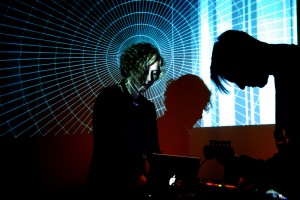 MM: It was one of the biggest things I can imagine. I was honoured and I was completely nervous about it. At the beginning I had all these questions – how can we do it? How will it turn out? Is this crap? Is it possible to do it? In a good way, I didn’t know. But from the very beginning my choice was to work together with Michael – the first guy that I’ve ever asked to do something for ‘Puppet on a String’, and also a friend of mine, so I was very close to him anyway. I knew he was a good guy and I knew he would give it the right treatment. We had a nice conversation the whole time. He was here in my studio and we had a look at the arrangement and he had the imagination for what he could do in an orchestra – this can be a part for a choir, what can you do there? – so we had a dialogue. And he had a plan right before he was starting to write down the score. We knew theoretically what each musician would do, what would be the part of the orchestra, what would be the part for me. But it was a big challenge for the orchestra as well, and for the choir, until we brought them all together on one stage. If you look at the video, you’ll see that the choir starts out with the paper thing, they do a kind of scrunching noise, so they don’t sing until minute three or four. They have to do funny things with their feet and stuff like that. So for the whole performance, the plan was to go along with this John Cage approach. My music doesn’t have measures or beats per minute.
MM: It was one of the biggest things I can imagine. I was honoured and I was completely nervous about it. At the beginning I had all these questions – how can we do it? How will it turn out? Is this crap? Is it possible to do it? In a good way, I didn’t know. But from the very beginning my choice was to work together with Michael – the first guy that I’ve ever asked to do something for ‘Puppet on a String’, and also a friend of mine, so I was very close to him anyway. I knew he was a good guy and I knew he would give it the right treatment. We had a nice conversation the whole time. He was here in my studio and we had a look at the arrangement and he had the imagination for what he could do in an orchestra – this can be a part for a choir, what can you do there? – so we had a dialogue. And he had a plan right before he was starting to write down the score. We knew theoretically what each musician would do, what would be the part of the orchestra, what would be the part for me. But it was a big challenge for the orchestra as well, and for the choir, until we brought them all together on one stage. If you look at the video, you’ll see that the choir starts out with the paper thing, they do a kind of scrunching noise, so they don’t sing until minute three or four. They have to do funny things with their feet and stuff like that. So for the whole performance, the plan was to go along with this John Cage approach. My music doesn’t have measures or beats per minute.
MT: There’s no rhythm, right?
MM: Yeah, nothing at all. And one of Michael’s great ideas was to play with clocks – no conducting. Everybody was looking at clocks. You see at the beginning these great clocks on the screen, and everybody was looking – OK, this is 1:20, now it’s my part to do this. It’s a very John Cage-y thing. It’s not possible to conduct fragments like that. It was a timetable and that’s the magic touch.
MT: Did you have much interaction with the rest of the orchestra and the choir, or was that all done through Michael?
MM: I was there for two rehearsals and I knew what they’d do, and after that, I had a conversation with Michael – oh, I don’t like this, what do you think of this – so we discussed a few things, but most of the time, Michael was the leader and communicated with all the musicians. It was very quick – we only had one rehearsal with the orchestra, the day before we performed – and I had two rehearsals with the choir, but I had nothing to do; I was just a listener. So it came together very quickly and Michael was the communicator. And on stage as well – everybody knew what to do when the time was there, so we didn’t have to look at Michael as a conductor, but you see him conducting the choir – louder, louder, stay – you see what he did with his hands. So they looked at him and he was the medium, and I had my timetable and did my thing like the other people on stage as well. I looked at the clock and played my parts when I had to.
Markus Mehr – Gymnasium/Swarms (Live with Orchestra) from Hidden Shoal on Vimeo.
MT: Last time we spoke, you talked about the duality of your work and the relationship between warm and cold, and organic and inorganic. When your samples are rendered live by an orchestra and electronic music becomes acoustic, or when the choir starts bursting into chatter to mimic the sample you have, is that the ultimate realisation of what you’re trying to do with opposites?
MM: Yes, I would say so. But it’s unusual – you spend so much time trying to find new sounds or to tweak sounds to make them sound new or different or inorganic or strange, and often the sounds came from natural instruments. You tweak knobs and then it doesn’t sound like a trumpet. And all of a sudden you stand on stage with someone playing a trombone, and he’s playing the sound again like an elephant – that’s strange. It’s the opposite of what you tend to do. It comes full circle. Believe me, it’s so strange. But it’s so much fun – I guess if we were to have this conversation five or six years ago, maybe I wouldn’t feel so comfortable with it because my direction was to move away from anything like music. That’s still the direction. But I think it has a sense of humour, or it’s more relaxed, to put it back together in wood and instruments and hear my music in a classical context. Sound-wise, it’s so impressive, if you stand on stage with an orchestra, and I’d never done that. That alone is a wonderful experience – I wouldn’t want to miss that. And everybody involved was so kind and so friendly and so ambitious to do this right for me. I have to point out that nobody in the choir knew me. Some of the musicians on stage knew me from previous projects, but everybody was so keen to make the best of the track, and what Michael did with the arrangement was a blast.
MT: Are there any plans to do something like that again? You mentioned you were collaborating with Michael on something else.
MM: A few days after, Michael and I sat in my kitchen, and we were very ambitious about putting it together again. We had some plans to do the whole album like that, but to be honest, this is not possible. You can’t put together an orchestra, you can’t hold together this choir – it takes too much time and money. And also for Michael as a conductor and as a writer – it took a few days for him to score it. It would be a dream, but I don’t think it will happen again. So, to be honest, I think this was it.
MT: What else are you working on right now? What’s coming up in the future for you?
 MM: At the moment, I’m working on a few things. When we finish this interview, I’ll go back to work on the next couple of albums. I’m working on the last two tracks for the next album, and that’s pencilled in for release in March. So I want to finish that, hopefully this week or next week. After that I’m working on another album – a new project called Low Delayer with my dear friend, Tom Hessler. It’s not completely different to my sound, but it’s quite different. I’d say we are swimming in the pool of post-techno. We’re working with modular synthesizers and my field recordings, bringing both worlds together and doing something that’s not really connected to techno in a pure form, but it has a kind of dance-y feeling. We only play with sounds and make rhythm-like things with sounds recorded from lights, light bulbs, display boards, etc. No drums. Hidden Shoal will release a remix EP from my current album in October, which I’m putting together at the moment. Along with that I’m doing some live performances on my own, and in October, Stefanie and I will play some shows with our new performance, Re-Directed, in Germany and Sweden. So, that’s happening in the coming weeks.
MM: At the moment, I’m working on a few things. When we finish this interview, I’ll go back to work on the next couple of albums. I’m working on the last two tracks for the next album, and that’s pencilled in for release in March. So I want to finish that, hopefully this week or next week. After that I’m working on another album – a new project called Low Delayer with my dear friend, Tom Hessler. It’s not completely different to my sound, but it’s quite different. I’d say we are swimming in the pool of post-techno. We’re working with modular synthesizers and my field recordings, bringing both worlds together and doing something that’s not really connected to techno in a pure form, but it has a kind of dance-y feeling. We only play with sounds and make rhythm-like things with sounds recorded from lights, light bulbs, display boards, etc. No drums. Hidden Shoal will release a remix EP from my current album in October, which I’m putting together at the moment. Along with that I’m doing some live performances on my own, and in October, Stefanie and I will play some shows with our new performance, Re-Directed, in Germany and Sweden. So, that’s happening in the coming weeks.
MT: And is Low Delayer something you’re going to do with Hidden Shoal, or something you want to do with another label?
MM: We want to finish the whole project first. I was in Berlin last week and we did three tracks, very rough. That was a three-day session and we picked three pieces from what we did, so now we can see the material clearly. We will have at least 40 minutes of music, and when it’s finished we will think about what we want to do with it. There are no other plans, but there are definitely plans to release it, that’s for sure. I’m not a guy who lets things get stale on my hard disk. I want to release it. Cam at Hidden Shoal will be one of the first to hear it.
MT: And as for the new album under your name, what can you tell us about that? How’s it sounding, how’s it different?
MM: Well, I’ve finished two different pieces. Re-Directed is one, and a second one, called Dyschronia, is finished as well. To be honest, I’m not sure which one I want to release first. That’s a luxury! Re-Directed deals with the abuse of power in connection with modern technology and communication devices. For this project I recorded tons of sound from servers, hard disks, mobile phones and stuff like that. It’s interesting how different they all sound, by the way. On Dyschronia I’ve experimented with a very different workflow. I’ve been working on that material for more than four years now. It’s about breaks in time, about leaving things alone and coming back, leaving them alone again and coming back again. It’s about sticking with things, looking at them in different ways and from new perspectives in order to observe how things – in this case, sounds – change over time. Time is a luxury in the modern world we live in. I know, musically this says nothing – you’ll have to listen to it when it’s released.
Slow Motion Cinema – An Interview with Half Film
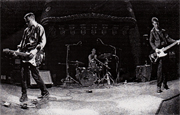 Half Film plays trance music. Not the mindless beat-driven sort you find in sweaty clubs, but the kind of sounds that put you into a deeply meditative state where you confront your deepest fears and converse with your truest self. What little writing I can find about them dubbed them slowcore, a sub-genre which, like most things branded with the unfortunate –core suffix, barely scratches the surface of defining an aesthetic. They’re slow in the way evolution is slow, their music unfolding at a snail’s piece, substituting traditional song structure and climaxes for a measured burn of emotion. Perhaps more than anything they’re cinematic, carefully crafting scenes with repeated motifs, scenes unfolding like blooming flowers as Eimer Devlin, Conor Devlin and Jason Lakis narrate what feels like the end of the world over brooding textures and measured, haunting guitar lines.
Half Film plays trance music. Not the mindless beat-driven sort you find in sweaty clubs, but the kind of sounds that put you into a deeply meditative state where you confront your deepest fears and converse with your truest self. What little writing I can find about them dubbed them slowcore, a sub-genre which, like most things branded with the unfortunate –core suffix, barely scratches the surface of defining an aesthetic. They’re slow in the way evolution is slow, their music unfolding at a snail’s piece, substituting traditional song structure and climaxes for a measured burn of emotion. Perhaps more than anything they’re cinematic, carefully crafting scenes with repeated motifs, scenes unfolding like blooming flowers as Eimer Devlin, Conor Devlin and Jason Lakis narrate what feels like the end of the world over brooding textures and measured, haunting guitar lines.
It’s been over a decade since Half Film split. The San Francisco trio released two LPs during their short run – 1998’s East of Monument and its 2000 follow-up, The Road to the Crater, both of which were re-released by Hidden Shoal in 2012.
The three have since scattered across the world – Jason hovered around California and now resides in Berkeley where he’s working on a new record for his sort-of-solo project Mist and Mast. In 2002, Conor and Eimer joined with members of Swell to form [the] caseworker (whose last two albums Letters from the Coast and Voices Out There were put out through Hidden Shoal) before going on an extended in hiatus in 2006. Conor moved to South Africa and now lives in Switzerland; Eimer left for Ireland but is back in Northern California. Along with the rest of [the] caseworker, they’ve spent the last few years demoing a third record by e-mail which will see the light of day in 2015 under the moniker AWMA. Here, the trio discuss the music they made at the turn of the century.
“We never felt [our records] got properly released for reasons I won’t go into,” Jason tells me over e-mail. I probe for a few days but it seems the frustrations are too deep to dig up. Eimer offers the same sentiment: “Just reading some of the references to old acquaintances gives me a stomach ulcer.” Conor opts not to name names, but chalks his discontent up to “a bottomless well of incompetence,” – label mismanagement, perennially intoxicated distributors and plain bad luck.
Half Film – ‘Coated’
Yet the resonance of the music over-powers any lingering angst over the machinations of a bloated industry. How could it not? Every track on East of Monument is catchy in the strangest possible way – almost anti-catchy. The songs embed themselves into that strange part of your brain that’s active when you’re halfway between sleep and wakefulness.
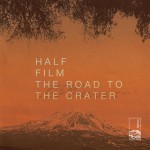 “I have very good memories of writing the songs, the rehearsals, hanging out,” Conor says. “But as others will tell you, I find having to listen to the records very traumatic. I feel they were never as good as what we (or maybe just I) heard in our heads, and there’s a gap between what you want to do and what you’re capable of. And when I hear the records, I’m hearing that gap and I assume everyone else hears it too. Having said that, when I had to hear the songs again recently to make sure the re-mastering went to plan, I could still hear very clearly what we were trying to express at the time, and I thought it was an honest expression of who and what we were at the time. We weren’t faking anything. ”
“I have very good memories of writing the songs, the rehearsals, hanging out,” Conor says. “But as others will tell you, I find having to listen to the records very traumatic. I feel they were never as good as what we (or maybe just I) heard in our heads, and there’s a gap between what you want to do and what you’re capable of. And when I hear the records, I’m hearing that gap and I assume everyone else hears it too. Having said that, when I had to hear the songs again recently to make sure the re-mastering went to plan, I could still hear very clearly what we were trying to express at the time, and I thought it was an honest expression of who and what we were at the time. We weren’t faking anything. ”
Eimer puts it another way: “I commute over the Golden Gate bridge a few times a week and since listening to the Half Film records again, as my bus approaches the bridge in the evening in my head I hear Con and Jay singing Hang and it gets me in the gut every time. I think that song means the most to me of any Half Film song.” Listening to Hang, it’s easy to get that same sense of despairing endless space; as the closing track on East of Monument, it carries the heart-breaking weight of an elegy to a something precious long since lost.
Half Film – ‘Machines, Hawks And The Perfect Equation’
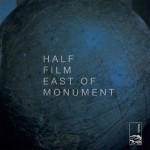 “Listening to the old Half Film discs – especially East of Monument – gives me a sense of nostalgia I don’t get from recordings of any of my other bands throughout the years,” says Jason. “I listen to ‘Coated’ and I get visions of the patterns on the walls of a club we played, the smell of a bar we hung out in.
“Listening to the old Half Film discs – especially East of Monument – gives me a sense of nostalgia I don’t get from recordings of any of my other bands throughout the years,” says Jason. “I listen to ‘Coated’ and I get visions of the patterns on the walls of a club we played, the smell of a bar we hung out in.
“Another thing about that time – there were a lot of little scenes, but we weren’t a part of any of them. I know that’s what everyone says, but it’s true. Other band’s members had played in each others bands for years. We were content along the sidelines, going to practice, then the bar (sometimes just the bar), then back to Conor and Eimer’s to listen to the day’s record store finds.”
Conor concurs. “We were definitely not a part of the scene; it felt natural to stay away. It still does,” he says. “San Francisco feels like a long way in the past now, but it’s great to look back and to have had such a unique experience while I was there. The memories are in the records.”
Check out East of Monument and The Road to the Crater at Half Film’s artist profile. The songs from both albums are also available for licensing through Hidden Shoal.
by Matthew Tomich.
The World On Tape – An Interview with Markus Mehr
Hidden Shoal’s Matthew Tomich spoke with Markus Mehr about his new album Binary Rooms, phonography and the art of sound.
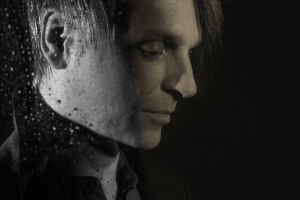 Under his solo moniker, Markus Mehr has made a career out of patterns. Before the release of his fifth record Binary Rooms last month, his last three albums – a triptych of interconnected ambient/drone records, beginning with IN in January 2012, ON 6 months later and concluding with OFF in January 2013 – were exercises in sonic ritual, building upon repetitions of harsh electronic noise, warm synths and ethereal sound manipulation. But on Binary Rooms, Mehr’s new preoccupation is with duality and the relationship between opposites: warm and cool, organic and synthetic, reality and fiction. Part of that latter juxtaposition comes because much of the material on Binary Rooms began as field recordings.
Under his solo moniker, Markus Mehr has made a career out of patterns. Before the release of his fifth record Binary Rooms last month, his last three albums – a triptych of interconnected ambient/drone records, beginning with IN in January 2012, ON 6 months later and concluding with OFF in January 2013 – were exercises in sonic ritual, building upon repetitions of harsh electronic noise, warm synths and ethereal sound manipulation. But on Binary Rooms, Mehr’s new preoccupation is with duality and the relationship between opposites: warm and cool, organic and synthetic, reality and fiction. Part of that latter juxtaposition comes because much of the material on Binary Rooms began as field recordings.
“I didn’t sit down and play a piano or play the guitar and see what’s coming out of me,” Mehr tells me over Skype from his home studio in Augsburg, Germany. “So it’s more a collecting kind of thing. Then you start out and play around with things. It’s more that a sound or a recording or a noise attracts me, and I want to find out what is it and what can I do with it. Can I extend it? Can I slice it? Can I trash it or can I refine it? Like everybody who does field recordings I always put my ear on things to find a spectacular sound. It could be a car that drives by my window. It could be my cat. He’s snoring and that’s a beautiful sound. And after that hunting, a lot of editing and processing follows up.”
“I’m basically a musician, but on Binary Rooms, most of the time I did non-musical things. I see myself nowadays as more of a phonographer. I look at what’s outside and what’s surrounding me. That’s maybe where the whole thing starts. ‘Gymnasium Swarms’ starts with a sound from my kitchen. So you can hear my heater here. It’s a very spooky sound.”
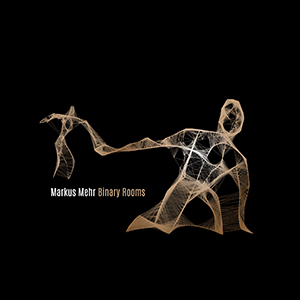 The result of Mehr’s new found interest in field recordings and found sounds is a record that’s diverse and brimming with aural contradictions. The eight tracks on Binary Rooms offer so much variation that it’s impossible to settle upon a mood for more than a single composition. Opener ‘Buoy’ is 2 minutes of claustrophobic and uneasy listening, littered with sparse and unsettling sounds that sound as though they could be metal scraping against metal, the plucking of an out-of-tune violin or something else entirely. It’s followed by ‘In The Palm Of Your Hand’ which marries pulsating synthetic percussion with a somber piano riff and street ambience, before the harsh glitches of ‘Pedestrians’ strike like an electric shock. What Mehr appears to be doing on Binary Rooms is inhabiting a creative space that situates him somewhere between composer, phonographer and assembler of the aural world around him.
The result of Mehr’s new found interest in field recordings and found sounds is a record that’s diverse and brimming with aural contradictions. The eight tracks on Binary Rooms offer so much variation that it’s impossible to settle upon a mood for more than a single composition. Opener ‘Buoy’ is 2 minutes of claustrophobic and uneasy listening, littered with sparse and unsettling sounds that sound as though they could be metal scraping against metal, the plucking of an out-of-tune violin or something else entirely. It’s followed by ‘In The Palm Of Your Hand’ which marries pulsating synthetic percussion with a somber piano riff and street ambience, before the harsh glitches of ‘Pedestrians’ strike like an electric shock. What Mehr appears to be doing on Binary Rooms is inhabiting a creative space that situates him somewhere between composer, phonographer and assembler of the aural world around him.
“[On Binary Rooms] I’m doing collages and putting things together to try to arrange new levels and new worlds,” he explains. “I try to redesign realities. I try to redesign reality in itself – maybe from A to B, you make C. To try to bring things together that usually don’t belong together – that’s exciting.
“For example, ‘Basin of the Lost’ is based on underwater recordings where all these really sad fishes swam in a tank, ready to become a burger or wha ever just a few hours later. And during the editing of the track, I don’t know why, but I thought a helicopter sound would be great. So in the real world these two audio events don’t belong together, but in the track – I mean, it makes sense somehow, and it keeps the whole thing weird and narrative. That’s the kind of work that interests me most right now.”
At 86 seconds, the track ‘Blackbox’ feels like an interlude, but buried beneath its oscillating synths is a fascinating subtext. Mehr initially began working on the then-unnamed song in 2013, and found himself applying some finishing touches on July 17, when less than a day’s drive from Augsburg, Malaysia Airlines Flight 17 was downed in Ukraine, killing all passengers on board. Though the title was eventually changed to ‘Blackbox’, Mehr initially named the track ‘MH17’ as a means to force himself to remember the tragedy.
“I had no title for that track,” he says, “and I thought, we have so much news – so many things around our head every day – and if we are honest, that tragedy is almost out of our minds right now. And it was very personal, because I’ve tried to make a mark in my mind that it happened while I was working on that track. There are so many tragedies we have to see on the screen and after two or three days they’re gone. I wanted to make sure that this one doesn’t go out of my mind anymore.”
Sound and Scene with Music Supervisor Steve Griffen
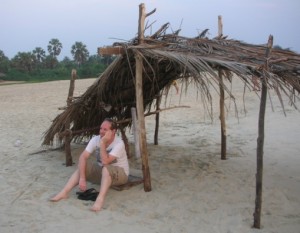 While few would dispute the importance of music in film and TV, I wonder how many outside the industry understand the machinations and the people that make it happen? Cue the music supervisor, who acts as a bridge between the vision and the music, and on a more practical level, the label/artist and the director/producer.
While few would dispute the importance of music in film and TV, I wonder how many outside the industry understand the machinations and the people that make it happen? Cue the music supervisor, who acts as a bridge between the vision and the music, and on a more practical level, the label/artist and the director/producer.
Steve Griffen has worked as a music supervisor in the US on such diverse projects as It’s Always Sunny In Philadelphia, Hot Tub Time Machine 2, We Are Marshall, the upcoming Mr Robinson (starring the awesome Craig Robinson), and many more. We’ve had the pleasure of working with Steve on the 30 Days In May documentary, which features nine songs from the Hidden Shoal catalogue, and we know he’s an in-demand, busy man, so we thank him greatly for taking the time to answer the following questions:
How did you get into music supervision?
It was actually forced onto me…somewhat. I worked primarily as a music editor in the beginning, and was editing on a television show when the network tried to force all of the shows to start using in-house music supervisors by not allowing supervisors in their budgets. The producers were used to having a supervisor attached to the production and offered me a raise to handle the supervision (since I was already employed as the music editor). There is a lot of crossover between editor and supervisor responsibilities, and the in-house supervisors did the ‘heavy-lifting’ when I called on them, so it made the transition somewhat painless.
What’s a day in the life of a music supervisor like?
The day always starts with reading a lot of emails over coffee. When I have time, I download the new music sent to me and try to give it a listen while travelling. I may have spotting sessions, concept meetings or mixes to attend. Whenever something music musical is taking place on the set, I am usually there as well. The rest of the time is spent auditioning songs against scenes, drafting requests and licenses or handling music editorial, which I also do on most of my projects. I go out to see bands a few nights a week as well in an attempt to stay current. One of the job perks is getting tickets to most of the shows that are happening every night in L.A.
I realise this must vary from project to project, but is there usually a specific point in the production process where you’re brought in? Does the point at which you join a project affect your approach?
It varies with each project, but I like coming in at the scripting phase. That allows me to avoid licensing pratfalls early on take part in a musically creative component of the job. If I get brought in after something is already shot or edited with music attached, the job is more about doing my best to fit the existing music into the budget or finding replacements for what cannot be licensed. Nobody is ever happy having to replace the music they have been living with, so those jobs can be problematic.
What’s been your favourite music placement and why?
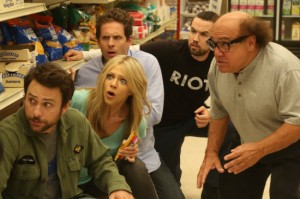 For the 100th episode of ‘It’s Always Sunny In Philadelphia’, they shot an intricate ninja fight sequence. We spent a lot of time trying out different songs for it and really loved “Smack My Bitch Up” by The Prodigy. There was a little back-and-forth with the band initially since they did not know the show, but after we forwarded them some episodes, they agreed. The publishers and label are all great people to work with, and the song worked on so many levels with the obvious nod to ‘Charlie’s Angel’s’. Plus, the song was misunderstood by a lot of people who took offense to it when it was released, similar to how ‘Sunny’ is often received.
For the 100th episode of ‘It’s Always Sunny In Philadelphia’, they shot an intricate ninja fight sequence. We spent a lot of time trying out different songs for it and really loved “Smack My Bitch Up” by The Prodigy. There was a little back-and-forth with the band initially since they did not know the show, but after we forwarded them some episodes, they agreed. The publishers and label are all great people to work with, and the song worked on so many levels with the obvious nod to ‘Charlie’s Angel’s’. Plus, the song was misunderstood by a lot of people who took offense to it when it was released, similar to how ‘Sunny’ is often received.
Without telling tales out of school, what was your hardest sync?
I’d have to say “Mama Said Knock You Out” by LL Cool J. There are a lot of samples in that track and even the samples have other samples in them. The pile of paperwork that it created made me feel guilty of deforestation.
Do you ever have to argue the value of a particular song to a director?
Constantly. It’s rare for everyone on a project to see eye-to-eye on music. It can be a polarizing topic that everyone wants to weigh in on.
I’ve heard it said, partly tongue in cheek, that music supervisors are the new A&Rs, and I know that many enjoy the ability to bring new music to new ears. Has this changed the way you think about your role or your choice of music in any way?
I don’t think my though process has changed because that’s how I’ve always viewed the role of a supervisor. I transitioned out of the record industry into TV/Film and had the chance to see guys like Danny Bramson doing more for the artists I worked with in the 90’s than the A&R department. I love seeing bands break after a great placement in one of my shows. It makes me feel still connected to the record industry in a small way.
How do you find the music you need for a project? Do you scout for music outside of a project to keep things tagged for future projects?
The music comes from all over the place, usually. Raiding the iTunes playlists of the interns on the show, seeing new bands in L.A., temp music from the editors, music scripted into the scene, etc…
I don’t really tag things for the future because that never seems to work out. Same with scripted music. It rarely ends up in the final cut. Producers and directions want to hear options and opinions from others. I have a somewhat photographic memory for songs so I’ll watch the scene down without music once it’s cut and sometimes I just know the song that’s needed. Then we are back to topic #6 above where I have to fight to keep it.
Can you tell us about the upcoming Mr Robinson project? (We’re big Craig Robinson fans!)
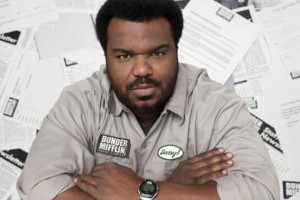 The pilot for that was done before I started ‘Hot Tub…’ and it’s still not in production! It’s supposed to be a mid-season replacement for this year so I expect it to start up soon. I can tell you that it’s based mainly on Craig’s real life as a struggling funk musician when he was starting out. He played on the recordings we did for the pilot and I engineered/produced those sessions. Hoping that his music remains a big part of the final show because I would love the chance to utilize my engineering skills regularly. Record budgets don’t usually allow for time in big studios anymore so the only way I get to sit behind a nice recording console is when I’m recording for TV/film projects.
The pilot for that was done before I started ‘Hot Tub…’ and it’s still not in production! It’s supposed to be a mid-season replacement for this year so I expect it to start up soon. I can tell you that it’s based mainly on Craig’s real life as a struggling funk musician when he was starting out. He played on the recordings we did for the pilot and I engineered/produced those sessions. Hoping that his music remains a big part of the final show because I would love the chance to utilize my engineering skills regularly. Record budgets don’t usually allow for time in big studios anymore so the only way I get to sit behind a nice recording console is when I’m recording for TV/film projects.
What’s spinning on Steve Griffen’s turntable at the moment?
Literally on the turntable? I think that’s probably “Dark Side of the Moon”, but the turntable is pretty much there as a conversation piece in my office. The top 10 recently most played songs on my iPhone are from Muse, Jimmy Eat World, Tame Impala, The Roots and Jack White. Okay…there’s a Tears for Fears song on the list too. Not sure how that fits into the above list.
Neil Diamond, Jason Lytle and Ghost Hunters – An Interview with Kramies
 American singer-songwriter Kramies has been honing his inimitable craft for many years, bewitching all who have heard his music along the way. Fusing masterful songwriting with electronics and atmospherics, stepping into a Kramies song means being swept up into an emotionally resonant vortex of swooning pop that simply demands repeat listens. His three Hidden Shoal EPs, The European, The Wooden Heart and The Folklore Sessions have been released to universal acclaim from around the world. We posed Kramies a few curly questions in order to delve a little into his music, his life and his creative process.
American singer-songwriter Kramies has been honing his inimitable craft for many years, bewitching all who have heard his music along the way. Fusing masterful songwriting with electronics and atmospherics, stepping into a Kramies song means being swept up into an emotionally resonant vortex of swooning pop that simply demands repeat listens. His three Hidden Shoal EPs, The European, The Wooden Heart and The Folklore Sessions have been released to universal acclaim from around the world. We posed Kramies a few curly questions in order to delve a little into his music, his life and his creative process.
Do you remember the first song you wrote?
Surprisingly I do. I remember mostly trying to make sounds with non-musical stuff. It’s weird because I remember being really young, around 9 years old, and liking the way my S’s sounded when I would put a pen cap under my lips. Ha! Or using a paper towel roll to sing through because I thought it made my voice sound distant. I’m not sure I should even share that stuff! Anyway, I believe the first song I ever wrote was called ‘Daisy’. I must have been 14. I used the paper towel roll effect and that’s when I started experimenting with a 4-track cassette recorder. It felt like such a big deal back then. I was the only kid with a 4-track and I made this ‘thing’ called ‘Daisy’! Ha! I’m sure I still have it somewhere. Fortunately I have forgotten every other song between that first one and the last 4 years, though.
Can you tell us a little about your early music career? How did it shape what you do now?
I was pretty shy and I’m sure the main reason I fell into music was because I received a little Casio keyboard and a toy acoustic guitar for Christmas. If it had been a toy ‘Easy Bake Oven’ that Christmas I probably would have pursued being a pastry chef. My shyness combined with these two instruments took up most my time. I was pretty bad, but I remember playing everything from my emotions. From there I joined a few bands in my town, but was not that great a player. In fact, one time I left my guitar at band practice and the guys carved ‘You suck’ into it, so I switched to bass! No one played bass in my town, so all of a sudden I was playing in the older kids’ bands and doing a ton of stuff musically. Still, I loved writing so I decided I would have to start and front my own bands. A few of those bands did some cool bigger things, but I always felt more comfortable writing and recording the stuff in my head more than being in a band. I always viewed writing songs and albums more like writing little books. It’s more of a personal adventure for me. I do believe working with a band helped me understand how to piece parts together while writing, but most of all it helped me become comfortable with what I do and to trust my instincts more.
Can you tell us a little about your songwriting process?
It seems to come in bursts, but mostly my songwriting starts with an image – something I see that sits in my head and then takes over my heart. It could be weeks or months before I start hearing it, then it seems to form into a phrase and melody that sparks a whole story. I usually write most of my stuff on acoustic guitar and write the lyrics first. I can spend days obsessing over the same three chords and mumbling the same words over and over. Then if I find myself waking up with the song parts still in my head, I won’t stop writing till it’s done. From there I’ll make a crappy demo of it and start writing and layering the other parts. I think it’s pretty basic, but for me the biggest part is to capture emotion and the image that originally started to grow in my mind. I become a bit like an obsessive crazy scientist over the process.
Does living in the mountains influence your songwriting?
Yes, tremendously. I think living near anything naturally beautiful like the mountains, which are so big and expansive, makes my mind wander. It wanders past normal everyday activities, which helps inspire my writing – it has such a huge effect on me. It feels very comforting to me to know I can get lost for a while in the mountains. Oceans have the same wonderful effect. I feel there is such a warm silence and understanding with nature that helps whatever songs I’m working on.
The lyrical themes in your work have such a vivid melancholic romanticism about them. They pair beautifully with the atmosphere of the songs and the production. Where does this lyrical imagery come from?
Wow, thank you, that’s so nice to hear! The lyrics have always been the most important part to me. I keep them very close to my heart. I never understood really where they come from or if they have meaning, but they definitely reflect an image or a story. I always seem to have a love for hauntingly romantic words. I don’t know where it comes from, but castles, ghosts of the past, old world imagery and poetic scenery always seem to influence my writing. I do remember at an early age wanting to just be a writer, but the music really helps push a story to a higher emotional range for me and helps create a kind of frame to sing through.
How did your collaborations with Jason Lytle (Grandaddy) and Grant Wilson (Ghost Hunters) come about?
Well, it’s a short blurry story that starts in the late 1990s. First, my bands back in the ’90s opened and played for a handful of great bands like Calexico, Spiritualized, Red House Painters and Grandaddy. Jason and I had some mutual friends and hung out in groups a few times. It wasn’t until around 2012 that we reconnected and started chatting about him producing a few of the songs for my EP The Wooden Heart. He is such a nice person and I was just blown away by how he turned all the simple little parts and songs I recorded into these bigger, more emotionally exposed and mature pieces.
Grant and I first had a strange brief meeting. It’s funny because I’ve watch his show Ghost Hunters on SyFy a lot and I was just doing a radio show and the interviewer mentioned how I seemed influenced by ghosts and haunting imagery, so he asked if I ever watched Ghost Hunters. Well, that same day, after the radio show, I visited the Stanley Hotel, and literally ran into Grant in the lobby of the hotel! It wasn’t until a few years later, when I discovered his beautiful piano music once The Wooden Heart was released, that I sent him a few songs. We share a love for the same musical sound. I was working on an acoustic follow-up to The Wooden Heart called The Folklore Sessions and asked him if he would like to play piano on a few tracks. It was a wonderful experience and I was blown away by how much beauty he added to my simple songs. Both Jason and Grant are amazing and very easy to work with.
Can you tell us what you do outside of making music?
I do a lot of art stuff. I seem to stay pretty creative. I find myself lost in mountain storms while on runs and I enjoy visiting little towns. I run a lot and I do a lot of yoga and meditation. But mostly I explore.
What’s spinning on the Kramies stereo at the moment?
I have a weird thing where I barely listen to music until I hear something that really pulls at my heart, then I listen to it a thousand times. So I’m not so good with what’s happening now and what’s new these days. I have Joanna Newsom, some older Jane’s Addiction, Glen Hansard, Indians, and Simon & Garfunkel in my stereo right now. Also there is a wonderful French band I love called A Singer Must Die too. There is a ton of wonderful Hidden Shoal artists as well.
Is it true that you share a house with Neil Diamond?
Ha! Yes, it’s true. Neil Diamond the cat dwells within my home. My wife actually named him Neil Diamond because of the white diamond on his chest – and the name stuck. He’s a bit of a celebrity here. He’s also known as The Creeper because you won’t see him for a while and then you’ll notice just his eyes and big grey head watching you from afar. He’s a very interesting creature and he lays next to me while I write.
What’s next for Kramies?
There’s an overseas tour that’s been postponed twice, but will actually happen this spring. I’m working on a new EP for 2015, and before that I will have a sort of obscure B-side release and a single with special guests and some new friends. Also, a few more interviews and live videos before I hide away to finish writing the new EP.
